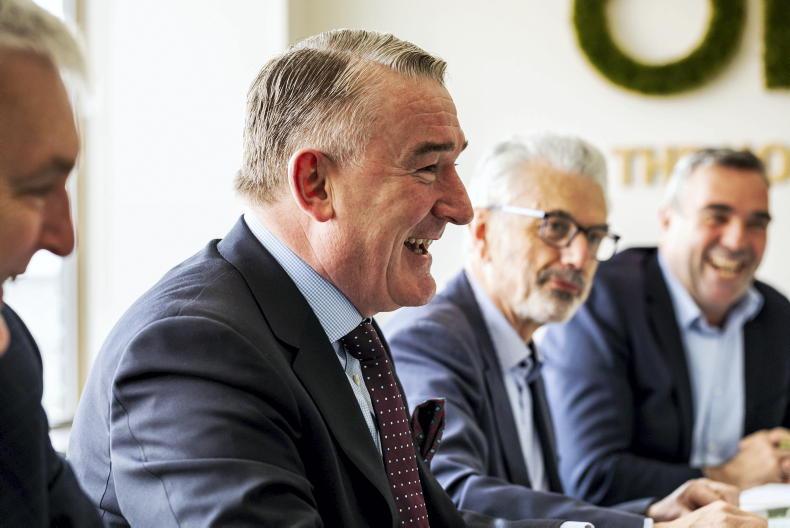Donal Buggy, Ornua’s chief financial officer, was in an optimistic mood when presenting the co-operative’s annual results this week.
After going through two years of COVID-19 and a “uniquely challenging” 2022, he points us towards Ornua’s five-year compound growth to give a better view of how the co-operative is performing.
It is no wonder that he is pointing at the number, as it shows a 13.2% compound annual growth rate for the period – a very strong number indeed.
However, as we can see from Figure 1 (below), much of that growth occurred this year, driven by very high commodity prices.
Those high prices accounted for the drop in operating profit this year, Buggy said, as Ornua deliberately absorbed some of the extra costs themselves in order to avoid hiking prices to consumers any more than necessary.
Squeezed middle
“We paid very high prices for our products and we deliberately didn’t pass on all those prices to our consumers, so we got squeezed in the middle.
“That’s a long-term tactic, as we want to maintain relationships with our consumers, while we also want our members to be in business and healthy for the long term.”
During the year, Ornua purchased €2.3bn of product from Irish co-ops, up from €1.5bn in 2021. The Ornua value payment totalled €72.5m in additional premiums and bonuses for member co-operatives.
“The basic price we pay each month should be a really good price,” CEO John Jordan adds.
“For Ornua, it is really important that everyone is in the room and understands where we are on policy. It takes Ornua, and co-ops and farmers working together to make this work. We’re on a mandate where it takes the three of us.”
The talk of “working together” means conversation turns to what the future holds.
The consensus across the table is that the supply-demand equation still favours buyers, but there are signs in recent weeks that those buyers are starting to become a little more active in the market.
Bernard Condon, MD of Ornua’s Global Ingredients Business, said that he is starting to see some signs that “we might be close to a bottom in the dairy market.”
He also noted that global supply is expected to fall slightly this year, which should help prices.
He is, however, quick to emphasise that the outlook remains uncertain and that any price recovery would be something which will come in the second half of the year.
Jordon seems less optimistic, pointing out that Ornua’s own purchase price index (Figure 2) has fallen sharply in the first three months of the year.
He does, however, expect an improved picture toward the end of the year as global supply reacts to prices.
He noted that the current price of milk would traditionally be seen as a strong price, but as the cost base for farmers has shifted so much in the last year due to inflation, old levels are meaningless.
Looking ahead for Ornua, the co-operative sees growth based on adding value rather than necessarily increasing product volumes.
Chair Aidan O’Driscoll said Ornua’s fresh five-year plan called “path to prosper” aims to stimulate growth while being committed to sustainable production. Part of the plan is to adopt science-based targets for sustainability for Ornua’s entire value chain.
Farmer levy: “Farmer funding levy to Ornua is not coming back” – Bernard Condon.
New board structure: “New board members and governance structure is bedding down well” – Aidan O’Driscoll.
Environmental ambitions: “We are signing up to science-based targets as a commitment in line with sustainability strategy.
“It would be easy to talk about net zero, etc, but we need to keep it locked into science. Farmers are not the villains in the environmental space” – John Jordan.
Return on Kerrygold brand to farmers: “Our shareholders, our co-ops, get paid a good price for product and then we deliver the Ornua value payment on top of that. It is down from €78m to €72.5m in total in 2022 as profits were down” – John Jordan.
Will Ornua grow: “The Ornua new five-year strategy is for modest growth for forecasted similar volumes of product, but, a higher proportion of added value components which means less skimmed milk-type product” – John Jordan.
How much milk Ornua buys: “Ornua buys the milk equivalent of four billion litres of milk each year from co-ops, about half the milk produced in the Republic of Ireland. Co-ops make a commitment at the start of the year and if actual milk supply from co-ops is down in the year then the commitment falls by the equivalent amount” – Bernard Condon.
Purchase requirements: “A key part of our sustainability strategy is supporting the Bord Bia sustainable programme (SDAS) and the ICOS updated calf welfare charter, which is incorporated into purchase agreements we have with each of the co-ops” – John Jordan.
